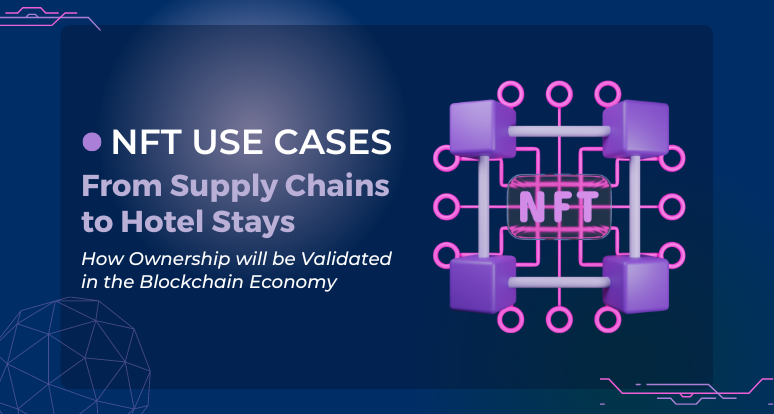
How Ownership will be Validated in the Blockchain Economy
The meteoric rise in popularity of NFTs, while primarily driven by hype, has overshadowed the unique and functional uses NFTs can perform. Beyond the Bored Ape Yacht Club, there are many use cases of NFTs that will change the way we function in the world. Whether it’s creating a booking system for hotel stays, proving the authenticity of high-end fashion goods, or empowering artists, NFTs are demonstrating that they are the unassuming digital workhorses of the blockchain economy.
First things first. What’s an NFT?
An NFT is a non-fungible token. They are digital tokens, contracts, or files where ownership is verified on the blockchain. Each NFT has a unique value and is therefore not like a money token that is fungible and interchangeable in a 1:1 exchange.
The value of an NFT is based on many factors, including the scarcity of the NFT, its practicality, and its sentimentality to the user. Additionally, as with any investment, part of the intrinsic value of an NFT is derived from its short- and long-term resale value. Ownership can be transferred, allowing an NFT to be traded or shared.
The NFT market is a $25 billion market and has grown 200x since 2021.
Supply Chain Superiority
Prada, Louis Vuitton, and Cartier have teamed up to use blockchain to ensure that customers buying high-end luxury consumer brands are getting the real deal.
In the case of bags and watches, a customer receives an encrypted certificate of guarantee that is only available on originally produced items. In another first, in 2018, Walmart teamed up with IBM to create a blockchain tracking program on all its produce so as to empower themselves in the event of an outbreak of food-borne illness. In trial searches using mangos and pork, by tracing certifications and temperature logs, Walmart cut the tracing time from 7 days to 2.2 seconds.
A Ticket to Stay
SolidBlock recently launched NFTstays, a program to increase revenue and occupancy rates with an NFT marketing system for hotels and resorts.
NFTstays works with hotels to mint a specific number of NFTs that includes a package deal of night stays and exclusive perks and benefits that can be purchased ahead of use. The platform uses innovative blockchain technology that generates brand awareness and is a way to expand publicity for hotels. Specifically, this technology removes the difficulty of compensating guests for unused rooms by giving guests the ability to resell their night stays with ease.
The hotel’s collection of NFTs, with each NFT containing unique art and photos of the hotel, is housed on the OpenSea platform. The NFTs are redeemed using the hotel’s existing booking system, promoting integration with the way the hotel functions. No additional technology is required. This is the first time NFTs have been used for hotel bookings in the United States.
The first hotel to use SolidBlock’s NFTstays platform is the NoMo Soho, owned by Sapir Corp, Ltd., and one of Sapir’s flagship properties. The boutique hotel, located in the Soho neighborhood of Manhattan, has been trending on Twitter since Sharon Raz, the CEO of Sapir was interviewed by Reuters News.
The advantages for the hotels in using NFTs for bookings include increased prepaid occupancy, a build-up of loyalty and brand awareness through perks and benefits, and a way to broaden publicity through an untapped source of revenue in the NFT marketplace. Guests can also secure competitive pricing at a time when New York hotel rates are rising, with the caveat of being able to sell the unredeemed NFT if they cannot use it.
As @NateNFT, one of the first purchasers of NoMo Soho’s NFTs, expressed on Twitter, “Just bought an NFT to book my hotel stay in NYC and I’m never going back to the old way!”
“The NFT market will grow and shift to utility solutions,” explained SolidBlock CEO and Co-Founder Yael Tamar. “SolidBlock is reframing how we use NFTs by creating practical use cases to bring unique value to the hospitality sector and its guests.”
No More Altering Grades
It used to be that with a sharp knife and a black pen, a wily high school student could change her F to a B on her report card. But what happens when, instead of a paper certificate, a student receives an NFT not only for their academic record but also for their attendance statistics?
NFTs can be coded with a unique set of information to represent documentation such as academic certificates, licenses, medical records, and certificates of birth and death. The tokenized document which is issued directly on the blockchain as an NFT can be traced back to the owner. This allows the owner of the NFT control over their data that is stored and protected digitally.
Spin this out further and NFTs can be used to identify and record an individual’s identity, allowing them to vote in any given election. This would certainly lessen the issue of identifying individuals who may not have an address or any physical paper documentation that proves who they are and where they reside in the country. Imagine being able to vote in whichever city you happened to be in on the day of an election because your NFT proves your identity.
Real and Unreal Estate
When the real estate agency Propy sold the first property in history as an NFT in 2021, the process operated slightly differently than a traditional real estate sale. The ownership of the property was actually held and recorded in Ukraine as a US LLC. The auction winner became the owner of the NFT that gave the rights to the LLC. Propy developed the smart contracts and complied with the legal framework that was necessary for the transfer of ownership within the US market. When the NFT changed hands—all without a shred of paper—the apartment belonged to a new owner.
Using NFTs and blockchain in the real world could also be an efficient way to verify titles and check the ownership history of specific properties.
While the sale of real-world property as NFTs is still in its infancy, NFTs are used for the sale of virtual real estate in all of the metaverse playgrounds.
Digital real estate investing is a serious business. When Decentraland had an initial coin offering (ICO), it sold more than $24M in MANA in less than 35 seconds. A virtual plot bought in January 2021 for $2,000 increase in value in two months to $175,000. Last November, the most recent purchase of a plot of LAND in Decentraland was bought for a record $2.34M by Metaverse Group which is more than double the previous record for a sale of land or property within a virtual reality world. The 500-square-meter plot will be used to host virtual fashion shows for avatars that can be bought with MANA, creating a closed economic cycle within Decentraland.
Republic Realm is also building a metaverse-like virtual world, and in November, launched a virtual cruise ship in that realm.
Investing in digital real estate is simple. In the transfer of the real-world real estate, money is exchanged for real property and the transaction involves banks, finance companies, lawyers, and title companies. In a similar manner, virtual real estate is exchanged, usually for virtual currency, in the form of NFTs. These more decentralized financial transactions cut out the banks, but do allow for automated checks such as KYC (know your customer) and AML (anti-money laundering) that are built into the NFTs’ smart contract.
Web 3.0 and the Creator Economy
The advent of Web 3.0, a more user-centric, decentralized, private, and secure version of Web 2.0, has also been dubbed the Creator Economy. Stuck at home during the pandemic, a dramatic rise was seen in the number of people connecting to their online lives. For example, the growth in podcast listening among 12- to-34-year-olds jumped from 27% in 2017 to 49% in 2020.
Not only did podcast audiences rise but more people began to channel their creative sides by writing and creating music, recording their thoughts, and making art. Platforms that paid writers based on the popularity of the articles they posted burgeoned. For artists, especially first-time creators, maintaining control over their creations and minting them as NFTs became a way to reach a worldwide audience hungry to own the sublime and the silly—and make a buck while doing it.
Ultimately, the use of NFTs in our daily lives is about the transparency and accessibility of data that cannot be tampered with, and the ability to control our data (or creation) in ways that are beneficial to us. For example, the big upside of SolidBlock’s NFTstays is that hotel guests now have an easy way to sell their purchase—an NFT representing 3 or 5 nights in a hotel—if they can’t use it. A quick post on Twitter, a link to the OpenSea NFTstays collection, and there are no telling how many times that NFT will change hands.
About SolidBlock
Founded in 2018 and headquartered in Israel, SolidBlock is a leader in Tokenization as a Service (TaaS) for real estate. As blockchain fuels change in the way real estate is transacted, the tokenization of real-world assets on SolidBlock’s platform empowers asset owners to transact differently—buy, sell, raise capital, and collateralize—and to manage their tokenized property on a secure, immutable, transparent system.
SolidBlock is integrating blockchain and Web3 technology with real-world assets and businesses. We provide the tools that unlock the value of an asset’s liquidity and administer the records for every real estate transaction on the blockchain. SolidBlock’s real estate tokenization platform is a bridge to a decentralized financial (DeFi) ecosystem and the Web3 blockchain economy.
In addition, SolidBlock’s NFTstays program provides new opportunities for hotels to discover additional sources of revenue and marketing channels with the use of NFTs. For more information: www.nftstays.com.

 by
by 

